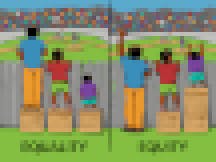My first year of teaching began in the stifling basement classroom of a public elementary school in a part of Newark, N.J., where crushed crack vials and occasional shootings were as much a part of the culture as lively Hispanic rhythms. I promised myself that my teaching would make a difference in the lives of my 38 children.
That fall, I found myself watching a young woman, we’ll call Omayra, through the glass doors of the school. Her first words to me: “You be wasting your time here.”
Omayra primarily dealt drugs, helping to create conditions that ravaged my Newark neighborhood. Yet in a way she was also a teacher. She engaged with my children on a level that eluded and challenged me. She knew their world: the richness of their community; the aspirations of their families; and the internalized hopelessness they carried into my classroom. She helped them cope with struggles I barely understood, and in the process, she earned their trust and respect.
Omayra was also my teacher and a guardian of sorts. My car was never keyed; the windows were never broken and I felt strangely safe exiting the school doors well past dark.
The irony is that Omayra and I were actually born in the same Newark hospital to immigrant parents whose economic circumstances contributed to uncertainty and displacement during our formative years. Our stories might have converged in a totally different way but for the small ripples of life that carried us in divergent directions, in my case to a suburban, middle-class community that offered access to transformative personal and academic experiences. It wasn’t until later that I realized what our different experiences indicated about the U.S. education system and the issue of educational equity.
The Learner-Centered Approach
There’s a two-frame educational cartoon that speaks to how we, as a nation, have conceived of this challenge. In the first frame, a trio of kids and adults are standing by a fence; only some are tall enough to see over it. In the second, kids are standing on boxes of varying heights that enable them to all see over the fence.

When I began my teaching career, policymakers were enthralled by the second frame, reasoning that if we achieve “equity,” all kids are able to see over the fence. They conflated this vision with scores on standardized tests. As I saw how Omayra was able to reach my students at a deeply human level that was somewhat beyond my 22-year-old self, I came to understand how this conflation stymied well-meaning efforts to advance true educational equity.
It is for this reason that I’m an advocate for transforming our education system from a school-centered one that emphasizes standardized notions of success to a learner-centered one that recognizes each child has unique gifts—and may take a non-standard pathway to achieve their potential.
This shift requires freeing ourselves from outdated notions of “success” and “equity” that too often reflect privileged, culturally-biased perspectives. I think of equity in two resulting parts: equity of the “academic experience” (the intellectual, cognitive aspects of education) and equity of the “human experience” (how education allows a student to access their full humanity).
Let’s start with the academic. In the U.S., we’ve been trying to jerry-rig a system designed to sift and sort kids, seeking to serve all students by more effectively articulating and teaching to a common set of knowledge and skills. Yet we then label and stigmatize kids whose cognitive strengths are different from some abstract idea of “normal.”
They have dyslexia or “learning differences.” They are autistic or have “special needs.” Or they suffer from vague emotional or affective disorders, many that reflect frustration with a system that can’t meet their needs. To safeguard against low expectations, we rely on standardized, “objective” measures. However, these tests have inherent cognitive and cultural biases, which prevent many students from demonstrating what they know and can do in the real world. We’ve perpetuated the belief that we can achieve equity by simply “doing” school better—and have little to show for it.
Learner-centered education doesn’t see cognitive differences as deficits to be remediated but, rather, as strengths to be built upon. Rather than labeling young people, learner-centered models like Montessori, Waldorf and Big Picture provide them with a range of ways to engage with ideas and content, including hands-on, embodied and experiential opportunities. Young people come to understand how they learn best—and receive support from adults in their community (inside and outside school walls) to create personally meaningful learning opportunities aligned to their strengths and needs.
Learner-centered education acknowledges that all kids won’t be in the same place when they finish school but empowers them to prepare for and select post-secondary opportunities that reflect their interests, strengths and aspirations. Internships and authentic community-based projects are central learning experiences, rather than add-ons to a standardized pathway. And, learner-centered education allows young people to demonstrate and get credit for their learning in multiple ways, including portfolios, project-based learning opportunities and credentials. Not only does this reflect how the real world recognizes achievement, it also allows learners who may not test well the chance to demonstrate everything they can do.
The second part of equity has to do with how well education equips a child to realize their fullness as a human being. All families want their children to become happy, well-adjusted adults; have a stable home and make a fruitful living. By defining equity in terms of academic parity, we shifted our system from addressing students’ non-academic needs, a pivot that disproportionately impacts our most vulnerable children. In doing so, we actually deepened existing inequities. While people with power and privilege can provide their children the full range of experiences and resources they need to succeed, families in communities like Newark do not have the same ability, creating and exacerbating "social capital” gaps for young people.
Learner-centered education, on the other hand, opens the doors of our schools, connecting all kids with adults beyond their immediate sphere. Whether they are the beneficiaries of dominant power structures or have to overcome them, our equity efforts should focus on developing every young person’s capacity to see, understand and intentionally navigate these dynamics.
The True Quest for Equity
To achieve true educational equity, we must prioritize the supports we know young people need to be healthy: authentic relationships, a sense of purpose and relevance, as well as pride in and connection with their communities. These are the same things that help mitigate the impacts of poverty and instability—as well as ensure young people can cope with trauma and stress. And these are the structures that students need to engage and thrive academically.
There are emerging conversations about the need for change. However, I do worry that many initiatives around social-emotional learning; whole child learning; and diversity, inclusion and culturally-responsive practices represent band-aids on a system that is not equipped to meet the human needs of children.
Transforming our approach to educational equity won’t be easy. But reforming our school-centered system hasn’t been easy either, and it has incurred unexpected costs. My journey has persuaded me that striving toward a learner-centered system will get us much further in our quest for equity.
I have an idea for a third frame in that education cartoon. In this one, a few kids will happily look over the fence, aided by different sized boxes—or maybe by periscopes or drones. Others will dig under the fence or climb over it. And, still others will paint it, take it down or even walk away in search of a different view. This frame captures the mindset we need to ensure that each child is recognized for who they want to be in the world—and receives the support they need to realize that aspiration. It’s the shift that will empower us to build a world, along with our children, that respects and reflects the diversity of human potential.
I’m driven by Omayra’s observation that “schools don’t do nothin’ for nobody.” My vision is a system where she is wrong.


